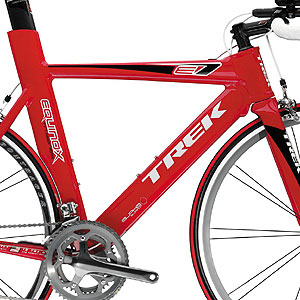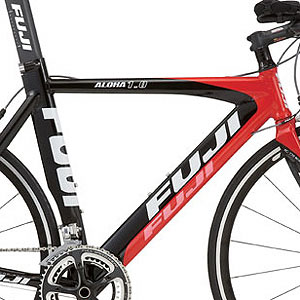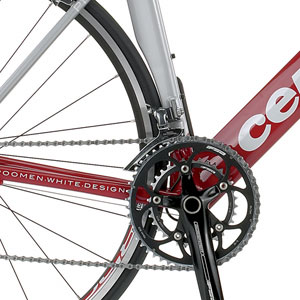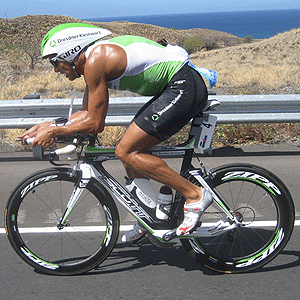Entry-level tri bikes: Trek and Fuji

If you go back just a few years ago, there were many more complete tri bikes sold in the $1400 to $1800 range. Specialized, Cannondale, Giant, Guru, Javelin, and others all had bikes for sale in or around this price category. Not so today (late add: Giant still makes bikes in this price category). There are certainly more than the six we're reviewing on Slowtwitch, but not many more, and not among the majors.
This is a category offering diminishing returns for manufacturers. Margins are low, minimums to manufacture are high. Customers are fewer, because the $2500 to $3000 all carbon complete bike is the hot category. Retailers are reticent to order in a size run except from a stellar, flagship brand, and that pretty much means Cervelo, maybe Felt, and maybe Quintana Roo. Nevertheless, there are two other models that ought to be taken seriously, and we'll write about them here.
Trek
Thank goodness Lance is back racing, because Trek has an image problem. "Trek?" you might say? Yes, vaunted Trek, at least in triathlon, and the problem is at the point of sale.
The problem is this: If a customer steps into a shop and Trek is that shop's flagship tri bike line, can one blame the customer if he spins on his heels and walks out? No Cervelo? No Felt? Where's QR? What about Kuota? But if that shop has these other popular tri brands, Trek is considered, even by the retailer carrying the bikes, subordinate to several or all of these other lines in tri bike desirability. Trek can't win for losing. Even though it is thought of by many as the premier road bike company in the world—maybe the premier bike company period—it still has an image problem when it comes to its tri and TT bikes.
And it's not fair, because Trek's Equinox TTX is a superb bike. Trek offers probably one of the top half-dozen tri bike lines going. There's so much about these bikes to admire. But we're not going to talk about the upper three-quarters of Trek's tri bike line here, because this is an overview of entry level bikes. So, we're going to talk about the Equinox 7, which is Trek's entre into the tri bike category.
Equinox 7
This bike sells for $1870, MSRP, and while your retailer might sell you this bike at a slightly lower price, it's still $300 above you'll expect to spend for the entry level Felt and $100 more than Cervelo's P1. And because those bikes are pretty darned good, Trek's got to offer something a little better to justify the bump in its sticker price.
For an aluminum frame, Trek's done a fine job. In fact, you have to look close to know it's not the carbon TTX frame. The tube diameters, construction, the shape of the fork, and frame graphics, are pretty close. The seat angle is a nominal 76° throughout the size run, but the frame uses the same palindromic seat post as does the TTX, so you can flip it and get the saddle equal or better than 80° of virtual seat angle, if need be.
There are six sizes, compared to three for the TTX. In some cases, the Equinox 7's geometry is perhaps slightly better than the corresponding TTX size. For example, the 58cm sizes in both models are the same in height, but the Equinox 7 is 6mm longer. The Equinox TTX could be a bit longer in this size, and it might fit a slightly greater cross section of people. In other words, the cheaper Trek's geometry is arguably a bit stronger than the more expensive Trek's geometry in this 58cm size.
But Trek's tri bike geometry tends to be a little scattershot. In 54cm we see the opposite: the TTX is longer than the Equinox 7. But that's because the TTX in its 54cm and 56cm sizes differs only 1cm in length, but 4cm in height. The sizing is not that well graded in the TTX, making the TTX work well for a variety of morphological rider profiles, depending on the size.
But that's typical for a lot of bike companies. They make these carbon molds, and in hindsight realize they could have done some things differently. But they're stuck for several years, until new molds come out. Not so the welded aluminum bikes. These geometries can be changed on a dime, which is why the Equinox 7, though the downscale model, arguably enjoys more intuitive geometries than the TTX.
Even in its smallest sizes, the Equinox 7 is pretty good. It continues with 700c wheels throughout the size run while Felt, QR and Cervelo all switch to 650c wheels, more desirable in the smallest sizes. But the Equinox 7 frame in its 50cm size has an unbelievably short 75mm head tube and, combined with an internal headset, makes this the lowest front end you can get with a 700c wheel. If you're short, and you absolutely have to use 700c in your tri bike, the Equinox 7 frame is the one. Honestly, it would probably be a better fit for Levi Leipheimer than the smallest TTX size he's currently riding in the TTs.
This bike is outfitted with honest, but not sexy, spec. At $100 more than the Cervelo P1 it is a 105-equipped drivetrain, while the cheaper P1 is Ultegra throughout, except for the crank, where Cervelo chooses FSA and Trek stays with Shimano. Also, Bontrager is going to have to prove that its Race Lite clip-ons are the equal of the bars made by the traditional aerobar makers like Profile Design and Visiontech. As is the case with Felt, Bontrager (Trek's house brand) must demonstrate that their house-branded aerobars are successful projects.
All in all, the Equinox 7 is a fine bike. There is a women's version, the Equinox 7 WSD, but most folks need not bother. The men's version enjoys better geometries for most people, women included.

Fuji
I used to hate Fuji's tri bikes. But that was in the old days when the Aloha was just so entry level. After the rest of the world had gone to threadless headsets the Aloha was still spec'd with a quill stem and it was only this side of rideable if you were a snob like me.
But that was then, and then was upwards of a decade ago. Now the Aloha his different. In fact, it's pretty sexy. And it's a nice match for retailers who choose to stock the underrated Kestrel Airfoil Pro, because that bike doesn't have any entry level, and Fuji—Kestrel's sister brand—does.
It was quite an irony to see Rock Racing using Fuji bikes for time trials and Kestrels for the road stages. But Fujis they were during the timed events, and what Fuji has taught itself in its design of its upper end TT bikes has found its way into the Aloha. Simply put, Fuji did what Specialized, Trek, Cannondale and other companies did: they finally decided to pay serious attention to this category—maybe for triathlon market reasons, maybe just so that it could sponsor top pro cycling teams—and good bikes triathletes will want are the end result.
Aloha 2.0
The 2009 Aloha sports many of the frame features that you'll find in bikes made by QR, Cervelo and Felt: aero tubes, including a seat tube and post acting as an aero unit, and a carved out rear wheel.
The circa-78° seat angle geometry is sane, up to a point. This is a fine bike and a fine value, down to 54cm. The problem is Fuji's insistance on using 700c wheels on its smaller sizes. The difference in the height of these bikes between 50cm, 52cm and 54cm is a whopping 5mm. In other words, in each of these sizes you're looking at bikes virtually all the same height. But the length of these three bikes differs by almost 35mm. The bikes get longer, but not taller; that is, the 54cm is just a stretched version of the 50cm. So, what's the better geometry between these bikes? Probably, for most people, the 54cm. So, this bike is best in its 54cm thru 60cm sizes (4 sizes in all).
If I have a problem with the bike's spec, it is in some of the chintzy drivetrain choices. The bike is 9sp, who makes a 9sp bike these days? The cassette is Sunrace, the chain is KMC. The front derailleur is Shimano Tiagra, and it ought to be 105 (which is what they use for the rear derailleur) in a $1600 bike. Compare this to Cervelo's P1, where both derailleurs, cassete and chain are all Shimano Ultegra. Of course, the P1 is $150 more. But then the Felt S32 is Shimano throughout its drivetrain, and it's $500 less. I would rather see Fuji add $100 to the price of this bike and just make it a 105 or Ultegra shift system.
Nowadays, things are not as they were a decade ago. It used to be a component driven market. Now triathlon is frame driven. Let's face it, the cassette and chain I'm whining about are what we call "consumables." Like tires and tubes, the bike will way outlive the OE-spec'd chain and cassette. What's nice about the Aloha is the big upgrade in frame versus this model of just a few years ago. This makes the Aloha twice the bike it used to be.




Start the discussion at slowtwitch.northend.network